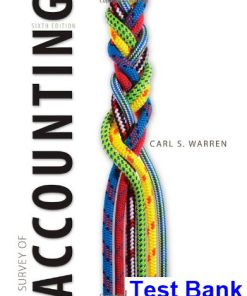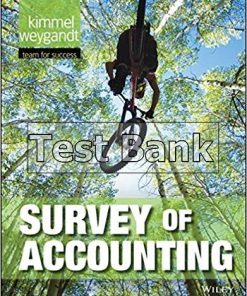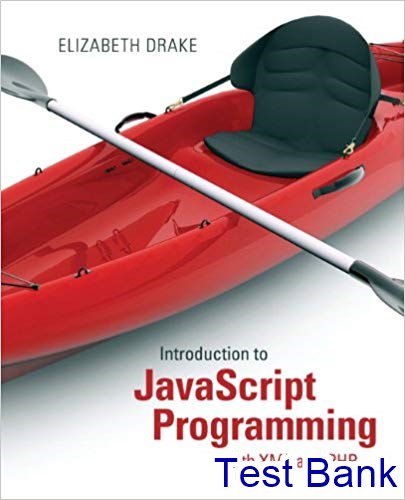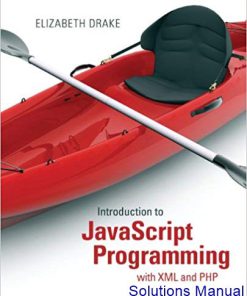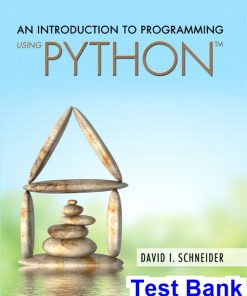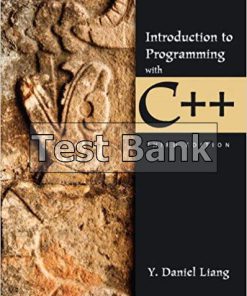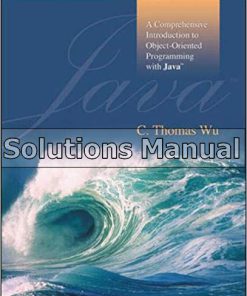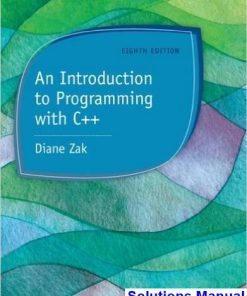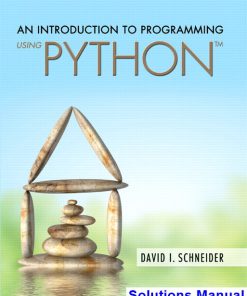$26.50$50.00 (-47%)
In stock
Introduction to JavaScript Programming with XML and PHP 1st Edition Drake Test Bank.
Category: Test Bank
Tags: Drake, Introduction to JavaScript Programming with XML and PHP, Test Bank
You may also like
Introduction to JavaScript Programming with XML and PHP 1st Edition Drake Test Bank
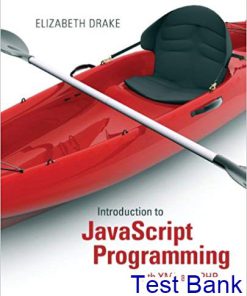
Product details:
ISBN:0133068307
ISBN-13:9780133068306
Authors: Elizabeth Drake
For a one-semester JavaScript programming course for students who have knowledge of HTML and CSS. This text also serves as a useful reference for individuals interested in learning JavaScript Programming with XML and PHP. ¿ Introduction to JavaScript Programming with XML and PHP is a hands-on book that focuses on the “how-to” aspects of JavaScript, with a focus on enhancing and extending websites
Table contents:
- Computer Basics
- 1. A Brief History of Computers
- a. What is a Computer?
- b. Personal Computers
- c. Today’s Computers
- 2. A Brief History of the Internet
- a. Packet switching
- b. Transmission Control Protocol and Internet Protocol (TCP/IP)
- i. Try it yourself
- c. What Is a URL?
- i. The protocol
- ii. The web server
- iii. The domain
- iv. The path
- v. Is all that necessary?
- 3. Computer Basics
- a. Input
- b. Processing
- c. Storage
- i. Internal memory
- ii. Mass storage devices
- d. Output
- 4. What is Programming?
- a. The History of Programming
- i. A brief timeline
- b. Types of Software
- i. Application software
- ii. System software
- c. Programming and Scripting Languages
- i. Machine language
- ii. Assembly language
- iii. Comparing machine language and assembly language
- iv. High-level languages
- v. Writing programs
- vi. Scripting languages vs. programming languages
- 5. Browsers
- a. What Is a Browser?
- b. Overview of Major Browsers
- c. How Does A Browser Work?
- d. Is the World Wide Web the Same As the Internet?
- e. What Does This Mean To You?
- 6. JavaScript and the Acronyms: XHTML, DOM, PHP, and XML
- a. A Brief History of JavaScript
- b. Web pages and XHTML
- c. Server-Side and Client-Side Technologies
- d. JavaScript Overview
- i. A dynamic language
- ii. First-class functions
- iii. A multi-paradigm language
- iv. How JavaScript is used
- e. Overview of DOM, PHP, and XML
- i. The Document Object Model: DOM
- ii. PHP Hypertext Preprocessor (or Personal Home Page Tools)
- iii. Extensible Markup Language: XML
- 7. Keywords
- 8. Review Exercises
- JavaScript Programming Basics
- 1. What is Programming?
- a. General problem-solving strategy
- b. The program development cycle
- 2. The Structure of a Program
- a. Input-processing-output
- i. input
- ii. processing
- iii. output
- b. The control structures
- i. Sequence
- ii. Selection
- iii. Repetition
- 3. Primary Data Types and Operations on Data
- a. Numerical data
- b. String data
- c. Boolean data
- d. Variables and Named Constants
- e. Assignment statements
- f. Operations on data
- i. Numeric operations
- ii. Character and string operations
- 4. Problem Solving: The Importance of Logical Thinking
- a. Planning a simple program
- b. Pseudocode
- c. Flowcharts
- 5. JavaScript in the Web Page
- a. The Tag Pair
- b. The Tag Pair
- c. JavaScript in a Web Page
- d. JavaScript in the document
- e. The Event
- 6. Introduction to Objects
- a. What is an Object?
- b. Properties and Methods
- c. The Document object
- d. Dot notation
- e. The write() method
- f. The GetElementById() method
- g. The open() and close() methods
- 7. Introduction to JavaScript Functions and Events
- a. Introduction to Functions
- i. Parameters
- ii. The prompt() function
- b. Introduction to Events
- i. Event-driven programming
- 8. Putting it to Work
- a. A Brief Explanation
- b. Greg’s Gambits: Enter the player’s name
- c. Carla’s Classroom: Enter the student’s name and age
- 9. Keywords
- 10. Review Exercises
- 11. Programming Challenges
- a. On Your Own
- b. Case Studies
- i. Greg’s Gambits
- ii. Carla’s Classroom
- iii. Lee’s Landscape
- iv. Jackie’s Jewelry
- Building Blocks: Variables and Operators
- 1. What is a Variable?
- a. Memory locations
- b. Variable names
- c. Declaring variables
- 2. Data Types
- a. A loosely typed language
- b. Numbers
- c. Strings and characters
- d. Named constants
- 3. Arithmetic Operators and Some Important Functions
- a. The modulus operator
- b. The hierarchy of operations
- c. The concatenation operator
- d. Parsing Integers and floating point numbers
- i. Using ParseInt()
- ii. Using ParseFloat()
- 4. Relational Operators
- a. ASCII code
- b. Relational operators
- 5. Logical Operators and the Conditional Operator
- a. Logical operators
- b. Boolean logic and Boolean operators
- c. The order of operations for logical operators
- d. The conditional operator
- 6. Putting it to Work
- a. Greg’s Gambits: Creating Your Own Story
- i. Developing the program
- ii. Writing the code
- iii. The CharAt() function
- b. Carla’s Classroom: A Spelling Lesson
- i. Developing the program
- ii. The functions
- iii. Finishing up
- 8. Keywords
- 9. Review Exercises
- 10. Programming Challenges
- a. On Your Own
- b. Case Studies
- i. Greg’s Gambits
- ii. Carla’s Classroom
- iii. Lee’s Landscape
- iv. Jackie’s Jewelry
- Making Decisions: the Selection Structure
- 1. What if? Types of Selection Structures
- 2. The Single Alternative Structure: the if… Clause
- 3. The Dual Alternative Structure: the if…else… Clause
- 4. Nested Selection Structures
- 5. Compound Conditions
- a. Combining Relational and Logical Operators
- i. Logical operators revisited
- ii. a note about syntax
- iii. Using ANDs and ORs
- 6. The Multiple Alternative Selection Structures
- a. The if…else if… Structure
- b. Error Checking: Just the Beginning
- c. The switch Statement
- 7. Putting it to Work
- a. Greg’s Gambits: Madame Vadoma Knows All!
- i. the Math object
- ii. the Math.random() and Math.floor() methods
- iii. Developing the program
- iv. Writing the code
- v. Putting it all together
- b. Carla’s Classroom: An Arithmetic Lesson
- i. Developing the program
- ii. The return; statement
- iii. The counter
- iv. Getting ready to code
- 1. The plan
- v. The code in pieces
- 1. Level One code
- 2. Level Two code
- 3. Level Three code
- 4. A comment about checking the counter
- vi. Putting it all together
- vii. Finishing up
- 8. Keywords
- 9. Review Questions and Exercises
- 10. Programming Challenges
- a. On Your Own
- b. Case Studies
- i. Greg’s Gambits
- ii. Carla’s Classroom
- iii. Lee’s Landscape
- iv. Jackie’s Jewelry
- Going Round and Round: the Repetition Structure
- 1. Computers Don’t Get Bored with Repetition
- a. Loop basics
- i. Iterations
- ii. Writing test conditions
- 1. Beware the infinite loop!
- 2. Don’t let the user get trapped in a loop!
- 2. Types of Loops
- a. Pre-test and Post-test Loops
- b. The Pre-test while Loop
- i. Writing test conditions
- c. The Post-test do…while Loop
- i. Why use one rather than the other?
- ii. Formatting the output: the toFixed() method
- d. Sentinel-controlled Loops
- i. Formatting the output: the toLowerCase() and toUpperCase() methods
- e. Counter-controlled loops
- i. Using a counter
- ii. Shortcut operators
- 3. The for Loop
- a. The for Statement
- b. The Initial Value
- c. The Test Condition
- d. The Increment/Decrement Statement
- e. The Careful Bean Counter
- i. Curly braces: do we really need them?
- 4. Data validation
- a. The isNan() Method
- b. Checking for Integers
- c. Using Compound Conditions for Data Validation
- d. The charAt() Method
- e. The length Property
- 5. Putting it to Work
- a. Greg’s Gambits: Encoding Secret Messages
- i. What is Encryption?
- ii. The charCodeAt() and String.fromCharCode() Methods
- 1. Unicode and ASCII codes
- 2. The charCodeAt() Method
- 3. The String.fromCharCodeAt() Method
- iii. Developing the Program
- iv. Writing the Code
- v. Putting It All Together
- vi. Finishing Up
- b. Carla’s Classroom: Advanced Arithmetic Lessons
- i. Developing the Program
- ii. Writing the Code
- iii. The Code in Pieces
- 1. Level One addition code
- 2. Level Two and Level Three addition code
- 3. Subtraction
- iv. Putting It All Together
- 1. A note about code
- v. Finishing Up
- 7. Keywords
- 8. Review Exercises
- 9. Programming Challenges
- a. On Your Own
- b. Case Studies
- i. Greg’s Gambits
- ii. Carla’s Classroom
- iii. Lee’s Landscape
- iv. Jackie’s Jewelry
- Advanced Decisions and Loops
- 1. Some Simple Schoolroom Statistics
- a. It All Adds Up
- b. Computing Averages
- c. The Range
- d. Odd and Even
- e. Integer Accuracy
- i. The Math.round() method
- ii. The Math.floor() and Math.ceil() methods
- 2. To Continue or Not to Continue?
- a. The break statement
- b. The continue statement
- 3. Nested Loops
- a. Desk Checking
- b. Different Ways to Nest loops
- i. Which way should loops be nested?
- 4. Drawing Shapes and Patterns With Loops
- a. Drawing Shapes
- b. Using Loops to Create Patterns
- c. The mouse events
- 5. Putting it to Work
- a. Greg’s Gambits: The Battle Between the Wizard and the Troll
- i. Developing the Program
- 1. The button as a link
- 2. The web pages
- ii. Writing the Code
- iii. Putting It All Together
- b. Carla’s Classroom: A Grammar Lesson
- i. Developing the Program
- ii. Writing the Code
- iii. The Code in Pieces
- 1. The function and the outer loop
- 2. Check for valid selections
- 3. Displaying the story
- iv. Putting It All Together
- 5. Keywords
- 6. Review Exercises
- 7. Programming Challenges
- a. On Your Own
- b. Case Studies
- i. Greg’s Gambits
- ii. Carla’s Classroom
- iii. Lee’s Landscape
- iv. Jackie’s Jewelry
- Forms
- 1. What is a Form?
- a. The Most Basic Form
- i. The tag pair
- ii. The submit and reset buttons
- b. Returning Form Submissions
- i. The Common Gateway Interface (CGI)
- ii. Returning form data by email
- iii. Returning form data to a program
- 2. Form Controls
- a. Radio buttons
- b. Checkboxes
- i. The checked property
- c. Textboxes
- i. The label, fieldset, and legend elements
- d. Textarea boxes
- i. The email action
- 3. Hidden Fields and Passwords
- a. The hidden Form Element
- b. The password Form Element
- i. The substr() method
- 4. Selection Lists and More
- a. Selection lists
- i. The size attribute
- ii. The multiple attribute
- b. Enhancements for Form Elements
- i. The tabindex attribute
- ii. The accesskey attribute
- iii. The onfocus event
- iv. An introduction to the this keyword
- v. An image as an OK button
- 5. Putting it to Work:
- a. Greg’s Gambits: Player Information and Inventory
- i. Developing the Program
- ii. Writing the Code
- 1. The textbox functions
- 2. The radio buttons function
- 3. The checkboxes functions
- iii. Putting it All Together
- iv. Finishing Up
- b. Carla’s Classroom: Carla’s Progress Report Form
- i. Developing the Program
- 1. Carla’s categories
- 2. The page design
- ii. Creating the Form
- iii. Writing the Code
- 1. The textbox functions
- 2. The radio buttons functions
- 3. The textarea function
- 4. Generating the email message
- iv. Putting it All Together
- 8. Review Exercises
- 9. Programming Challenges
- a. On Your Own
- b. Case Studies
- i. Greg’s Gambits
- ii. Carla’s Classroom
- iii. Lee’s Landscape
- iv. Jackie’s Jewelry
- Keeping it Neat: Functions and JavaScript Source Files
- 1. Functions
- a. Built-in Functions
- b. User-defined Functions
- 2. The Scope of a Variable
- a. Global variables
- b. Local variables
- 3. Sending Information to a Function
- a. Passing Arguments to Parameters
- i. The return statement
- ii. Passing values: a complex issue
- iii. Passing by value
- 4. Objects and Object-Oriented Concepts
- a. The Math Object
- b. More JavaScript Objects
- i. Passing by reference
- ii. The Boolean object
- 1. The new keyword
- iii. The Date object
- 1. The setTimeout() function
- 5. JavaScript Source Files
- a. Work Smarter, Not Harder
- b. Creating and Accessing a JavaScript Source (.js) file
- i. JavaScript source files cascade
- c. Create a Library of Functions
- 6. Putting it to Work:
- a. Greg’s Gambits: Hangman
- i. Developing the program
- 1. The man in the noose
- 2. The secret words
- ii. Writing the code
- 1. The startHangman() function
- 2. The setCharAt() function
- 3. The replace() method and regular expressions
- 4. The revised checkWord() function
- iii. Finishing up
- b. Carla’s Classroom: Reading Comprehension
- i. Creating the first page
- ii. Writing the code
- 1. Password protection
- 2. The first web page
- 3. Use the visibility property to create a hidden button
- 4. Building the page with questions
- 5. What the student sees
- iii. Putting it all together
- iv. Finishing up
- 8. Review Exercises
- 9. Programming Challenges
- a. On Your Own
- b. Case Studies
- i. Greg’s Gambits
- ii. Carla’s Classroom
- iii. Lee’s Landscape
- iv. Jackie’s Jewelry
- Arrays
- 1. One-Dimensional Arrays
- a. Creating an Array in JavaScript
- b. The Array object
- i. The length property
- ii. Some methods of the Array object
- 2. Populating Arrays
- a. Loading Arrays Directly
- b. Loading Arrays Interactively
- c. Displaying Arrays
- d. Why Use Arrays?
- 3. Using Array Methods
- a. The push() Method
- b. The unshift() Method
- c. The splice() Method
- 4. Multi-Dimensional Arrays
- a. Introduction to Two-Dimensional Arrays
- b. Declaring and Filling Two-Dimensional Arrays
- 5. Putting it to Work:
- a. Greg’s Gambits: The Game of 15
- i. Developing the Program
- 1. Setting the stage
- 2. Creating the array with the setup() function
- 3. Populating the array with the Math.random() function
- 4. The code to exchange cell values
- 5. The code to check for a winner
- ii. Putting It All Together
- b. Carla’s Classroom: Images and Imagination
- i. Setting Things Up
- ii. Developing the Program
- 1. Setting the stage
- 2. The image swap
- a. Practice the image swap
- 3. The slide show
- iii. Putting It All Together
- 10. Review Exercises
- 11. Programming Challenges
- a. On Your Own
- b. Case Studies
- i. Greg’s Gambits
- ii. Carla’s Classroom
- iii. Lee’s Landscape
- iv. Jackie’s Jewelry
- Searching and Sorting
- 1. Sorting Arrays
- a. The sort() method
- b. Sorting numbers with the sort() method
- c. The reverse() method
- 2. The Bubble Sort
- a. Swapping values
- b. Using the Bubble Sort Algorithm
- c. Passing Arrays
- 3. The Selection Sort
- 4. Searching Arrays: the Serial Search
- a. Using the Serial Search With Parallel Arrays
- 5. Searching Arrays: the Binary Search
- a. The Binary Search
- b. Making Life Easier: the indexOf() Method
- i. The indexOf() method
- ii. The lastIndexOf() method
- iii. Time out! Using the setInterval() method
- 6. Putting it to Work:
- a. Greg’s Gambits: Greg’s Boggle
- i. Developing the Program
- ii. Setting the Stage
- 1. Creating the boggle() function
- 2. The toString() method
- 3. The boggle() function
- iii. Putting it All Together
- b. Carla’s Classroom: A Factoring Lesson
- i. Factoring Integers
- ii. Developing the Program
- iii. Setting the Stage
- iv. The Code in Pieces
- 1. The external file
- 2. The beginning
- 3. Selecting the number and some housekeeping tasks
- 4. Getting student responses
- v. Putting it All Together
- 7. Review Exercises
- 8. Programming Challenges
- c. On Your Own
- d. Case Studies
- v. Greg’s Gambits
- vi. Carla’s Classroom
- vii. Lee’s Landscape
- viii. Jackie’s Jewelry
- The Document Object Model and XML
- 1. The Document Object Model: DOM
- a. A Brief History of DOM
- b. DOM Nodes and Trees
- c. The Family: the Parent-Child Model
- d. Creating and Inserting Elements
- i. The createTextNode() method
- e. Replacing and Removing Elements
- i. The removeChild() method
- ii. The replaceChild() method
- iii. The childNodes property
- 2. Using DOM Methods with Timers and Styles
- a. The setAttribute() and getAttribute() Methods
- b. The setInterval() and clearInterval() Methods
- 3. XML Basics
- a. What is XML?
- b. Why Do We Need XML?
- c. XML Components
- i. The XML declaration
- ii. XML elements
- iii. Comments and filenames
- iv. XML attributes
- v. XML entities
- vi. Whitespace
- vii. Well-formed documents
- d. XML Parsers and DTDs
- i. XML internal DTDs
- ii. XML external and public DTDs
- 4. Adding Style and XSL Transformations
- a. Using Cascading Style Sheets with XML Documents
- b. The Extensible Stylesheet Language (XSL)
- i. One important note
- 5. XML Namespaces and Schemas
- a. XML Namespaces
- i. The Uniform Resource Identifier (URI)
- ii. Namespace declarations
- b. XML Schemas
- i. Creating a reference to a schema in an XML document
- ii. There’s more…
- c. XML Schema Datatypes
- d. Creating an XML Schema
- 6. Putting it to Work:
- a. Greg’s Gambits: Greg’s Avatars
- i. Developing the Program
- ii. Setting the Stage
- iii. Creating the XML, XSL, and JavaScript Pages
- 1. Creating the XML page
- 2. Creating the XSL page
- 3. Creating the JavaScript page and DOM code
- iv. Putting it All Together
- b. Carla’s Classroom: A Spelling Lesson
- i. Developing the Program
- ii. Setting the Stage
- iii. The Code in Pieces
- 1. The functions to extract values from the selected image and spelling
- 2. The function to compare the values
- 3. The function to check for success
- iv. Putting it All Together
- 7. Review Exercises
- 8. Programming Challenges
- a. On Your Own
- b. Case Studies
- i. Greg’s Gambits
- ii. Carla’s Classroom
- iii. Lee’s Landscape
- iv. Jackie’s Jewelry
- PHP: An Overview
- 1. A Brief History of PHP
- a. What Does a Server Do?
- i. HTTP get and post request types
- b. The Apache HTTP Server, MySQL, and PHP
- i. The Apache HTTP server
- ii. The MySQL database
- iii. PHP and XAMPP
- 2. XAMPP
- a. Installing XAMPP
- i. Security
- ii. The license
- iii. The install
- b. Try It Out
- i. Let’s get started
- ii. Your first PHP program
- 3. PHP Basics
- a. PHP Filenames, the htdocs Folder, and Viewing Your PHP Pages
- b. Variables and Methods
- i. Converting datatypes with the settype() and gettype() methods
- ii. Converting datatypes with type casting
- c. PHP Keywords
- d. Operators
- i. Unary operators
- ii. Binary operators
- 1. Operator precedence
- iii. Ternary operators
- iv. Concatenation operators
- 4. Using Conditionals and Loops
- a. Making Decisions: the Selection Structure
- i. The echo construct
- ii. The switch statement
- b. Cycling Through: Repetitions and Loops
- 5. Arrays and Strings
- a. Arrays
- i. The reset() method
- ii. The foreach construct, the as keyword, and the ==> operator
- iii. The key() method
- b. Why Are We Learning All This?
- c. Working With Strings
- i. Comparing strings
- ii. Searching for expressions: the preg_match() and preg_replace() methods
- 6. Putting It To Work
- a. Greg’s Gambits: PHP Welcome Messages
- i. Developing a new format for Greg’s pages: organizing a site
- ii. The header and footer files
- iii. Setting the stage
- iv. The ajax_post() function
- 1. The onclick=”javascript:ajax_post()”; event
- 2. The ajaxDataPipe.php page
- v. Putting it all together
- b. Carla’s Classroom: Using PHP for Hints
- i. Developing the program
- 1. The folders
- 2. The header.php file
- 3. The footer.php file
- 4. The carla_phpDemo.php file
- 5. The showHint() function
- 6. The gethint.php file
- 7. The $_GET superglobal variable
- 8. The count() method
- 9. The strtolower() method
- ii. Putting it all together
- 7. Review Exercises
- 8. Programming Challenges
- a. On Your Own
- b. Case Studies
- i. Greg’s Gambits
- ii. Carla’s Classroom
- iii. Lee’s Landscape
- iv. Jackie’s Jewelry
- Using PHP with Cookies and MySQL
- 1. Cookies
- a. Types of Cookies
- b. Writing Cookies
- i. The time() function
- ii. Writing and reading your first cookie
- iii. The define() method
- iv. The isset() method
- v. The $_SERVER(‘PHP_SELF’) method
- 2. A Database Server: MySQL
- a. An Overview of MySQL
- i. The license
- b. Setting Up a MySQL User Account
- i. Create a new user
- ii. Assigning privileges
- c. The Database Structure
- d. Building a Small Business Database
- i. Jackie’s tables
- ii. The primary key and the foreign key
- iii. Table fields
- iv. Field attributes
- e. Creating the Database With phpMyAdmin
- i. Create the jackiejewelry database
- 3. Populating a Database From the Web
- a. The Web Page Form
- i. The die() method
- ii. The mysql_error() method
- iii. The mysql_query() method
- iv. The mysql_connect() method
People also search:
introduction to javascript programming with xml and php
introduction to javascript in web development
introduction to javascript programming
introduction to programming using javascript
download solution manual of introduction to programming using javascript
Introduction to JavaScript Programming with XML and PHP 1st Edition Drake Solutions Manual












































